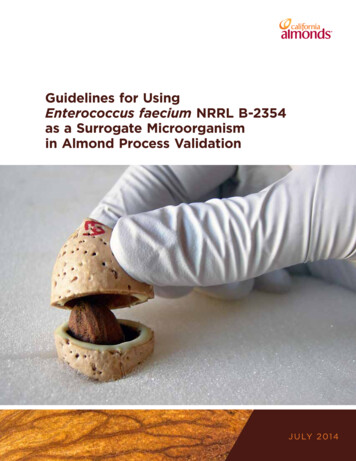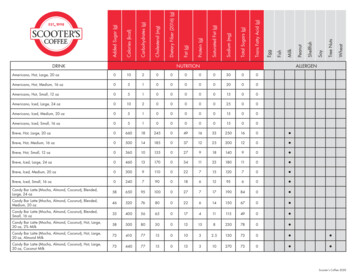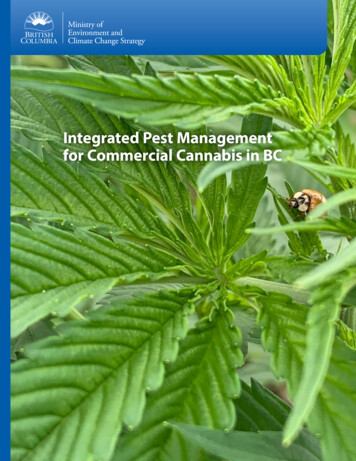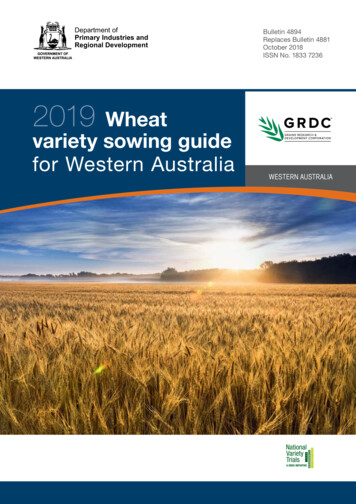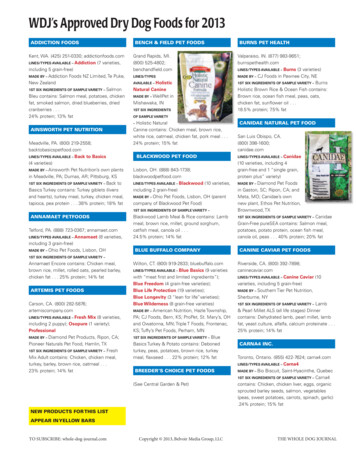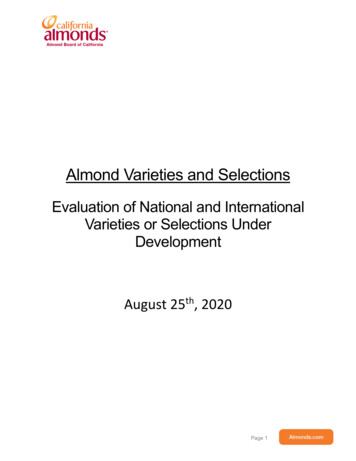
Transcription
Almond Varieties and SelectionsEvaluation of National and InternationalVarieties or Selections UnderDevelopmentAugust 25th, 2020Page 1
ContentsAcknowledgments . 3Introduction . 3Current California Almond Varieties . 4Evaluation of Variety Performance . 5Part I: Preliminary Results from Ongoing Regional Variety Trials (RVTs) . 5Background. 5Results . 9Horticultural Discussion of RVT.20Part II: Varieties & Selections Not Part of Current RVT .20Horticultural Discussion of Non-RVT Varieties .28Part III: Crack-Out Data, Hedonic Analysis, and Sensory Evaluations on All Varieties andSelections .29A.Crack-Out Data .29B.Hedonic Analysis and Sensory Evaluations .37Discussion .44Conclusions .45Priority Traits for New Variety Development .47Future Directions .49Appendix .50ABC Active Breeding Projects as of 2019-20 Fiscal Year .50Material, Methods and Additional Crack-Out Results .50ABC Almond Classification - Variety Poster .59ABC Almond Variety Classification -Technical Kit .60Index .62Page 2
AcknowledgmentsThe Almond Board of California (ABC) would like to thank the researchers who contributedinformation for this report. This report was authored by: Gina Sideli, Ph.D., University of California (UC), Davis, Post-Doctoral fellowship, Dr.Gradziel LabTed DeJong, Ph.D., UC Davis, Emeritus Professor, ABC ConsultantSebastian Saa, Ph.D., ABC, Associate Director, Agricultural ResearchAdditional technical input was provided by these co-authors: Tom Gradziel, Ph.D., UC DavisBruce Lampinen, Ph.D., UC Davis SpecialistPhoebe Gordon, Ph.D., UC Agriculture and Natural Resources (ANR) Farm AdvisorRoger Duncan, M.S., UC-ANR Farm AdvisorLuke Milliron, M.S., UC-ANR Farm AdvisorJoseph Connell, M.S., UC-ANR Farm Advisor, EmeritusSamuel Metcalf, UC Davis, Research StaffCalifornia and international nurseries and breeders who provided materials for the 2019Almond Board Crack-Out eventThe following ABC staff:o Guangwei Huang, M.S., ABC, Associate Director, Food Research andTechnologyo Karen Lapsley, Ph.D., ABC. Senior Director, Nutrition Research and SpecialProjectso Josette Lewis, Ph.D., ABC Chief Science Officero Ashley Knoblauch, B.S., ABC Specialist, Industry CommunicationsThe research presented here is supported by California almond growers and handlers throughthe Almond Board of California.IntroductionThe Almond Board of California began funding almond variety development research in theearly 1970s and expanded that effort to include rootstock breeding in the late 1980s, investingan estimated 8 million to today. In the last twenty years, this research has delivered five newUC varieties (Padre, Sonora, Kester, Winters and Sweetheart), and supported testing of mostcommercial varieties and rootstocks for overall performance, resistance to pests, diseases andabiotic stresses, providing growers with information on options for different growing conditions.Nurseries and private breeders have always played an important role in the introduction of newalmond varieties and, in particular, accessing international rootstock for commercial release inCalifornia. To provide a mechanism to test the performance of new varieties across the diversealmond growing regions in the state, and under different soil conditions, in the 1970s theAlmond Board began supporting long term and multilocational Regional Varietal Trials (RVTs),spanning from the following time periods: first trial: 1974-1981, second trial: 1993– 2006, thirdtrial: 2014–present.Page 3
In November 2019, the ABC held its first ever “Crack-Out” event with the purpose engaging theentire industry in a more comprehensive evaluation of new almond varieties. This event broughttogether public and private breeders, growers and handlers, hullers/shellers, UC researchersand nurseries to sample more than 60 varieties of almonds. ABC staff and UC researcherscollected nut samples from UC Davis and USDA breeding programs, private breeders, nurseriesin California, and leading varieties from Australia, Spain and Israel.Breeding is an art of balancing improvements while accepting some trade-offs. To define thisbalance, experts must consider the various segments of the almond industry, starting with thegrowers, moving to the hullers and shellers, handlers, food companies, and then, ultimately, theconsumer.Current California Almond VarietiesCalifornia produces about 30 varieties of almonds, with more than 98% of productionrepresented by 13 major varieties. Nonpareil, which is more than 120 years old, is the dominatevariety, accounting for about 40% percent of annual production. Nonpareil almond is a paper orsoft-shell variety with an attractive kernel of a medium size, uniform shape, smooth surface andlight (blond) colored skin. Nonpareil receives a premium price due to high market demand.Many other varieties have been developed as pollinizers for Nonpareil. A few of them havekernel or shell characteristics similar to Nonpareil, and they may be marketed as “NonpareilType”. Examples of these varieties are Sonora, Independence and Supareil. These varietiesalso have a wide range of applications: in addition to snacking, they can be cut to various formsfor ingredient applications.The remaining pollinizer varieties, with a wide range of kernel shapes and sizes, havetraditionally been marketed under two classifications according to their main kernelcharacteristics and uses: “Mission” and “California” types.Mission type varieties have small, short and plump kernels with wrinkled surfaces and darkbrown skin color. Butte, Padre, Butte/Padre (both varieties are often harvested together), Fritz,Mission, Ruby, and Marcona are marketed under this type for natural roasted, salted, and candyor chocolate applications. The major varieties in this group are Butte, Padre, Butte/Padre andFritz. For years Butte, Padre, and Fritz have also been marketed under “California” type as theyshare the blanchable characteristic that defines that type. In addition, down the road the currentMission type may be renamed after the common Butte/Padre or “for Roast and Candy Use.”Alternately, production of Mission and Ruby are diminishing, while Marcona has only a smallshare of production.The California type was established as input feedstock for manufacturing processes, i.e.blanching and slicing or slivering, about five decades ago. By definition, the varieties in thisclassification should be blanchable. Most major varieties produced in California except forMarcona can be marketed as California type. These include all Nonpareil type varieties; some“Mission” type varieties such as Butte, Padre, or Butte/Padre, and Fritz; and other varieties suchas Carmel, Monterey, Wood Colony, Aldrich, Price, Winters, etc. California type varieties have awide range of kernel shapes and sizes ranging from narrow medium, narrow long to narrowlarge, etc. with wrinkled surface and brown color. Due to high consumer demand for snackproducts, many varieties in this type are also used for roasting, salting or flavoring processes.Some of the varieties such as Carmel, Monterey, Wood Colony, etc., are also good for slicing orPage 4
slivering process because of their large kernel sizes. In terms of industry use, Carmelproduction is decreasing, Wood Colony has irregular or bulging shapes with a high percentageof twins while Monterey has a relatively high level of doubles, considered a less desirablecharacteristic. Therefore, these varieties may be replaced with more desirable varieties in thefuture or may be reclassified based on different processing uses. Indeed, as new varieties enterproduction, the classification of these varieties is an area for additional industry dialog.Evaluation of Variety PerformanceThe evaluation of new varieties and selections is subdivided in three parts, based on the sourceof the data presented:I.II.III.Results from the ongoing Regional Variety Trials (RVTs): These trials collect themost robust horticultural data available on newer almond varieties and selections beingtested in California and are conducted by the UC with support from the Almond Board ofCalifornia.Horticultural and quality data on non-RVT varieties and selections from CA andaround the world (Australia, Israel, and Spain). This data comes from promotionalmaterial, self-reported data from breeders and some published research.Data collected on all varieties during the Crack-Out event held on November 13,2019.Part I: Preliminary Results from Ongoing Regional Variety Trials (RVTs)BackgroundTo provide a mechanism to test the performance of new varieties across the diverse almondgrowing regions in the state, and under different soil conditions, in the 1970s the Almond Boardbegan supporting long term and multilocational Regional Varietal Trials (RVTs). All but one ofthe top 15 current California almond varieties, ranked by their total market share according to2019/20 crop receipts1, have been included in past or current RVTs funded by ABC (Table I-1).Table I-1. Top 15 California Almond and their evaluation in RVTs2019/20Receipts byVarietyKernels (lbs)OriginRVT#119741981RVT#219932006RV#32014 presentNonpareil (NP)1,045,977,062A.T. Hatch - Grower, Suisan, SolanoCounty, 1879xxxMonterey455,921,902Chance seedling, Merced 1962, NP xMission, US patent 3483, 1974xxButte/Padre194,532,090See belowIndependence156,723,441Private breeder, Zaiger Genetics 2008,available exclusively through Dave WilsonNurseriesCarmel119,283,990Chance seedling, Merced, 1966, NP xMission, US patent 2641xxSelffertilexView past ABC-issued monthly Position Reports for more information on crop es/crop-reports/position-reports.1Page 5
2019/20Receipts ByvarietyKernels (lbs)OriginFritz109,654,952Chance seedling, Manteca 1969, Missionx Drake, US patent 3005, assigned toBurchellWood Colony99,133,138Chance seedling, Modesto, 1985 USpatent 5583, assigned - BurchellxxAldrich89,363,689Chance seedling, Hughson 1973, USpatent 5320xxButte77,125,048Private breeder, F.W. Anderson, Merced,1963, Mission x NP assigned to FowlerxxMixed58,545,611Sonora29,477,605UC Davis - Kester, 1983, no patent, NP xEureka cross 1946xxPadre23,141,647UC Davis – Kester 1983, no patent,Mission x Swanson 1946Price19,211, 083Chance seedling, Durham, 1953, NP xMission, US patent 2350 1964Winters11,668,704UC Davis NP x Peerless & others, USPatent 13,286 P34 2006Supareil10, 2014 presentxxxXChance seedling, B. Crocker, ChicoxUS patent 21,934 2011, availableexclusively through BurchellRVTs are designed to evaluate new varieties or selections in a semi-commercial (20 to 40 treesper variety) manner and to compare them to standard varieties such as Nonpareil, Mission andcurrently accepted pollinizer varieties. Initial RVTs were established between 1974 and 1981 inKem, Colusa, Butte, San Joaquin and Fresno counties. Trees in these trials were planted overseveral years and made up of different ages and variety combinations. Thus, the data fromthese early trials was not directly comparable.In 1993, a more uniform RVT was initiated. This second RVT was conducted in Butte, SanJoaquin and Kem Counties. To be comparable, these three new trials were all planted in thesame year and with essentially the same variety composition. Thus, any differences in varietalperformance among various regions should have been evident. Collection of yield data from thesecond RVT was discontinued on most varieties in 2006. The results of these trails weresummarized and are available in a 2006 Annual Research Report available in the UC Fruit andNut Center: nal Almond Variety Trials/.In 2004, a limited variety trial was planted near McFarland (Kern County) to evaluate theperformance of eight clones of Nonpareil and eight pollinizer varieties. Production data on thistrial was collected from 2006 to 2015. For summaries of the results from this trial see the 2012,2014 and 2015 ABC Annual Research Reports titled “Field Evaluation of Almond Varieties” byBruce Lampinen et al. at https://rd.almondboard.com/Pages/default.aspx.A third, more uniform RVT was initiated with trees planted in 2014 in Butte, Stanislaus andMadera counties. 30 varieties and breeder selections were planted at each site (Table I-2) and afew additional genotypes were planted at individual sites. The source of the current RVTPage 6
genotypes includes collections from private nurseries as well as USDA and UC Davis breedingprograms. The thirty varieties and selections currently in the RVTs are a combination of recentlyreleased varieties and promising advanced selections, and 14 are self-compatible, with most ofthe new selections coming from the ABC-supported breeding program at UC Davis. Theadvanced selections combine California quality and adaptability with novel traits for selffruitfulness and disease and pest resistance. The advance selections also demonstrate a rangeof tree sizes, architectures and bearing habits required for developing more efficient orchardsystems in the future. A list of the materials in the current RVT are as follows:Page 7
Table I-2. Varieties and selections planted at the 2014 RVT. Trees at the Butte, Stanislaus and Maderasites were planted on Krymsk 86, Nemaguard, and Hansen 536 rootstocks, respectively (exceptions arenoted at bottom of table). Twelve selections are self-compatible, two selections are partially selfcompatible, and 16 have pollen incompatibility.VarietySourceProvided f-fru P16.013BurchellBurchellYesSelf-fru rtialSweetheartUCDFowlerPartial(2-19E) KesterUCDGradzielNo(2-19E) Kester/HansenUCDGradzielNoUCD 3-40UCDGradzielNoUCD 18-20UCDGradzielNoUCD 1-16UCDGradzielNoUCD 8-160UCDGradzielYesUCD 8-27UCDGradzielYesUCD 1-271UCDGradzielYesUCD 1-232UCDGradzielYesUCD 7-159UCDGradzielYesUCD 17-91-03USDALedbetterYesFolsomWilsonWilsonNoWood Colony*Sierra GoldSierra GoldNo* Wood Colony only planted in Butte County at California State University, ChicoAmong the data collected on each variety and selection in the third RVT are: timings of bloom, hull split and harvest,Page 8
yield and canopy light interception to help interpret and normalize yield data to accountfor differences in tree size/canopy volumes among genotypes and sites,kernel characteristics, andobservations on disease susceptibility, ease of harvest and other horticulturalcharacteristics.Further data, methods, and year-specific results can be found on the Almond Board’s ResearchDatabase: tsFor the purposes of this report only preliminary summary data from the most recent fouryears (2016, 2017, 2018, 2019) are presented. The first significant yields in these trials wereobtained in 2016 and full yields were not obtained until 2018 or 2019. The site with the highesttree density (Madera) obtained higher early yields than the other two sites. While the yield dataaveraged across all sites presented here probably do not reflect potential mature tree/orchardyields they do provide information about the general differences in performance of the variousvarieties and selections in the trials. The data on yields divided by canopy light interceptionprobably provide a better idea of the general yield potential of the varieties/selections, especiallyin these early years of the trials because much of the differences in yields among genotypesand sites are due to rates of tree growth and canopy volume. Thus, it is important to point outthat trees were planted at a spacing of 18’ x 22’ at the Butte site (110 trees/acre) on Krymsk 86rootstock, 16’ x 21’ at the Stanislaus site (130 trees/acre) on Nemaguard rootstock, and 12’ x21’ at the Madera site (173 trees/acre) on Hansen 536 rootstock.Bloom dateWith the exception of a few genotypes, the majority of cultivars in the RVTs bloomed within aten-day period at each of the sites. Furthermore, there was only a 1-3 day difference in averagebloom date of each variety among sites. The earliest blooming selection was UCD 3-40, havinga full bloom date within the second week in February (Table I-3). About 20% ofvarieties/selections had full bloom in the third week in February, and 68% (inclusive ofNonpareil) had full bloom extending into the fourth week of February. Only Kester on Hansenrootstock had an average bloom date of March 1.Page 9
Table I-3. Average full bloom calculated from adjusted means for three years (2017, 2018, 2019) for eachlocation (Butte, Madera, Stanislaus) in FolsomJenetteKesterKester/HansenLonestar rlingSupareilSweetheartUCD 1-16UCD 1-232UCD 1-271UCD 18-20UCD 3-40UCD 7-159UCD 8-160UCD 8-201UCD 8-27WintersWood 2602-2802-1602-21Full Bloom DateMadera 02-2202-2302-2302-2802-2602-28Lone Star only in Butte and Stanislaus 2017, 2018, 2Shasta only in Stanislaus 20191Page 10
Nut qualityCrack-out percentages were highest for Kester/Hansen, Eddie, UCD 7-159, Y117-91-03,Folsom, Bennett, Nonpareil and Jenette varieties (Figure I-1).Forty four percent of the genotypes had a crack-out percentage greater than 60 percent, with 42percent of the selections/varieties having more than 75 percent sealed nutshells. The percent ofsealed shells, as measured with from a fifty-nut sample, was highest among Kester, Self-fruitfulP13.019, Self-fruitful P16.013, Sweetheart, Capitola, Y121-42-99 and, Y117-86-03 (Figure I-2).The quality defect of percent doubles varied greatly among genotypes. There were a numberwith doubles less than 3% including Eddie, Sweetheart, UCD 7-159, Sterling, Supareil,Nonpareil, Y116-161-99, and UCD 1-271. Eight genotypes produced 10% or greater doublekernels: Booth, Self-fru P16.013, Wood Colony, UCD 8-201, UCD 18-20, UCD 8-27, Y 121-4299 and UCD 1-16 (Figure I-3). The percent of shriveled kernels was found to be below 3% inseveral varieties: Winters, Y121-42-99, Durango, UCD 1-16, Sterling, and Kester (Figure I-4).Page 11
Figure I-1. Crack-out percent calculated for each selection or variety in the RVT. Adjusted means werecalculated for the four years of data collection (2016, 2017, 2018, 2019) over three locations (Stanislaus,Madera, Butte).Page 12
Figure I-2. Percent sealed calculated for each selection or variety in the RVT. Adjusted means werecalculated for the four years of data collection (2016, 2017, 2018, 2019) over three locations (Stanislaus,Madera, Butte).Page 13
Figure I-3. Quality defect percent doubles calculated for each selection or variety in the RVT. Adjustedmeans were calculated for the four years of data collection (2016, 2017, 2018, 2019) over three locations(Stanislaus, Madera, Butte).Page 14
Figure I-4. Quality defect percent shrivel calculated for each selection or variety in the RVT. Adjustedmeans were calculated for the four years of data collection (2016, 2017, 2018, 2019) over three locations(Stanislaus, Madera, Butte).Kernel yieldThe tables below summarize the varieties’ yield performance of the varieties (Tables I-4A Table I-4C). Quality and defect characteristics are summarized in Table I-5.Page 15
Tables I-4A. Yield characteristics for 31 variety/selections in RVTs. Data displayed over four years (2016, 2017, 2018, 2019) from Butte triallocation and ranked by the 2018 and 2019 average yield per photosynthetic active radiation (PAR) intercepted.Variety orSelectionJenetteAldrichUCD 8-160Y116-161-99NonpareilUCD 18-20BoothBennettUCD 8-201DurangoWood ColonyY117-91-03Y117-86-03EddieUCD 1-16Self-fru P13.019KesterUCD 8-27UCD 7-159Kester/HansenSterlingWintersFolsomUCD 3-40CapitolaUCD 1-232SweetheartSelf-fru P16.013UCD 2018CanopyPAR(%)2018 Yieldper PARintercepted2019CanopyPAR (%)2019 Yieldper PARintercepted2018-19Avg Yieldper 623.019.918.2Page 16
Tables I-4B. Yield characteristics for 31 variety/selections in RVTs. Data displayed over four years (2016, 2017, 2018, 2019) for Stanislaus triallocation and ranked by the 2018 and 2019 average yield per photosynthetic active radiation (PAR) intercepted.Variety bs./ac)Cum.Yield(lbs./ac)2018CanopyPAR(%)2018 Yieldper PARintercepted2019CanopyPAR (%)2019 Yieldper PARintercepted2018-19Avg Yieldper PARinterceptedUCD 8-160UCD 18-20UCD 42-99Y117-86-03WintersBennettUCD 8-201DurangoSterlingKesterUCD 1-232BoothCapitolaY117-91-03UCD 1-271Self-fru P13.019JenetteUCD 1-16FolsomSelf-fru P16.013UCD 8-27SweetheartEddieSupareilUCD 26.426.326.125.0Page 17
Tables I-4C. Yield characteristics for 31 variety/selections in RVTs. Data displayed over four years (2016, 2017, 2018, 2019) for Madera triallocation and ranked by the 2018 and 2019 average yield per photosynthetic active radiation (PAR) intercepted.Variety orSelectionY116-161-99UCD 18-20Y117-86-03UCD 8-160Y117-91-03JenetteUCD 8-201KesterSweetheartY121-42-99UCD 1-16NonpareilWood ColonySelf-fru P13.019BennettWintersUCD 7-159UCD 8-27EddieSelf-fru P16.013AldrichSterlingCapitolaFolsomUCD 1-232BoothDurangoSupareilUCD 1-271UCD Cum.Yield(lbs./ac)2018CanopyPAR(%)2018 Yieldper PARintercepted2019CanopyPAR(%)2019 Yieldper PARintercepted2018-19Avg Yieldper e 18
Tables I-5. Quality and defects characteristics for 31 variety/selections in RVTs. Data displayed as means over four years (2016, 2017, 2018,2019) across three locations (Butte, Stanislaus and Madera). Data taken by Gradziel and Lampinen et al. 50 almonds per tree. Twin two kernelswithin the same nut. NOW Navel Orangeworm. Blank blank kernels.Variety/SelectionInshellwt. (g)Kernelwt. 2.584.87Kester/ ru 20.1110.661.236.200.76Self-fru 80.048.1618.700.580.038.711.125.1611.16UCD 459.473.252.841.19UCD .336.880.704.504.68UCD 4819.952.942.841.29UCD
Almond Board began supporting long term and multilocational Regional Varietal Trials (RVTs), spanning from the following time periods: first trial: 1974-1981, second trial: 1993- 2006, third . tested in California and are conducted by the UC with support from the Almond Board of California. II. Horticultural and quality data on non-RVT .





